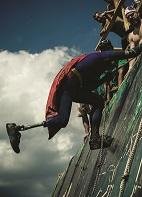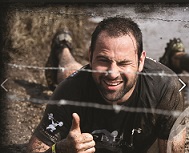

It’s difficult to explain why obstacle racing has gotten so popular so quickly but like most fitness phenomena, its growth is most likely attributable to a combination of factors. As a society, we have become increasingly stationary for decades now. We can get any kind of coffee we want, one cup at time. Our phones go everywhere with us and keep us connected to everything. We have access to countless TV channels, including those from around the world. Having all our needs met so easily has made us incredibly comfortable.
Obstacle racing, by contrast, isn’t comfortable or easy. It taps into something primal – the need to get outside and explore the world and do something physically challenging. It gets you dirty, it makes you work hard and when you’re done, it brings a sense of accomplishment. It also leads to increased physical fitness, something OCR athletes are always working on.

People tend to become involved with OCR events for different reasons. Sometimes, a really challenging sports event is on their bucket list. Sometimes, a friend is doing it and it sounds like fun. Sometimes, people try it because they’re at a transitional point in their life, such as when they’re between jobs or recovering from a divorce. In addition, OCR events allow you to go at your own pace (in other words, you don’t have to blast from obstacle to obstacle; you can walk or jog between them), which appeals to people who want to participate, but not necessarily be competitive with others. And while a traditional 5K race is competitive, OCR racers tend to use teamwork in order to get over obstacles. That aspect appeals to people as well.
We’ve had the ability to watch the dynamics shift, as well. Some obstacle races have been offering special events for children. We often see parents, particularly those who do a lot of OCR events, come to race a full event in the morning, then spend the afternoon walking beside their child as he or she navigates a one-mile course with some manageable obstacles. There are also a few races specifically designed for, and marketed to, women; it’s all a part of the OCR industry’s work to be relevant to everyone.

When OCR was just starting its growth, we did see plenty of people trying to jump on the bandwagon, as it were, and create their own races without an understanding of all that was involved. And as anyone who puts on sports events of any kind already knows, that’s not a recipe for success. There might be someone who owned a plot of land, and who knew someone with carpentry skills, and they would come up with an idea for a race, open a website and figure they were going to hit the jackpot. Only it didn’t work that way. Being successful in managing sports events, and OCR events in particular, takes its own knowledge base, and they didn’t have it. They would set up shop, not get the volunteers or the registration they wanted, and have to close up.
 Occasionally, a new event will be created by people who simply overprice the market. Force of Nature was launched in early 2015, and never put on one event. There’s only so much people are willing to pay, particularly if it’s a race they have never heard of before.
Occasionally, a new event will be created by people who simply overprice the market. Force of Nature was launched in early 2015, and never put on one event. There’s only so much people are willing to pay, particularly if it’s a race they have never heard of before.
Social media has made it harder for people to get away with bad behavior in the industry. The tight-knit OCR community makes its voice heard. They vote with their feet and their dollars and they’re not afraid to call people out for not doing a good job or not living up to their promises. And in the age of transparency, it’s harder than ever for a would-be race owner to blame their failure on a lack of registrants, a lack of volunteers, a lack of cooperation with city officials or anything else. If they don’t own their mistakes, they won’t get a second chance.
So at this point, we often get the question: where does the OCR event industry go from here? We don’t have a crystal ball, unfortunately. Still, the trends we see are very positive. The market saturation of all the “pretenders” from 2012 and 2013 is backing off, which means the people who really know what they’re doing should be able to keep on offering quality events. That means good experiences for both the longtime racers and those just joining the sport, and of course, that bodes well for the future.
 We know the market for what is called ‘non-traditional races’ is growing; just last year, Running USA released inaugural research on what it termed “non-traditional races.” Non-traditional races were those that varied from the classic, timed events such as 5Ks, 10Ks, marathons, etc.; examples would include untimed themed runs and OCR. The report stated that over the course of five years, “the number of estimated finishers in U.S. non-traditional events has grown from low six figures in 2009 to a staggering 4 million in 2013, a nearly hard-to-believe 40-fold increase. In addition, a handful of mass participation adventure series in 2009 has rapidly expanded to more than 35 non-traditional or themed running series.”
We know the market for what is called ‘non-traditional races’ is growing; just last year, Running USA released inaugural research on what it termed “non-traditional races.” Non-traditional races were those that varied from the classic, timed events such as 5Ks, 10Ks, marathons, etc.; examples would include untimed themed runs and OCR. The report stated that over the course of five years, “the number of estimated finishers in U.S. non-traditional events has grown from low six figures in 2009 to a staggering 4 million in 2013, a nearly hard-to-believe 40-fold increase. In addition, a handful of mass participation adventure series in 2009 has rapidly expanded to more than 35 non-traditional or themed running series.”
Will the sport be replaced by something else? That’s another question nobody can answer. Obviously, we love it and want it to stay around. But in general, OCR does seem to be in a very good place. The smart races will continue to hone their events and provide a quality brand that participants can depend on. The people who try to grow their events too big too quickly will go away. Many of the smaller independent races, the ones proud to call themselves ‘Mom and Pop’ events, put on quality events and have their attendance grow, year in and year out. So without trying to jinxing ourselves, it certainly looks like we can count on a bright future.

